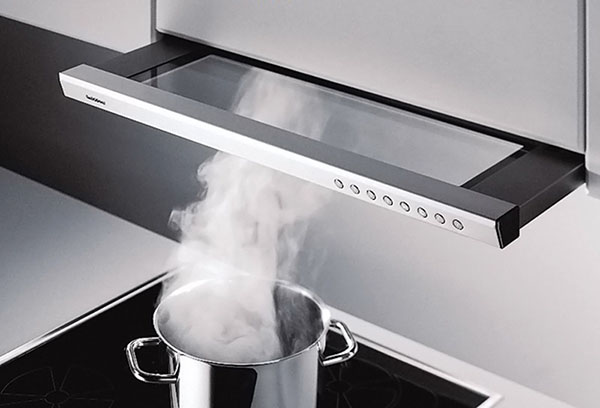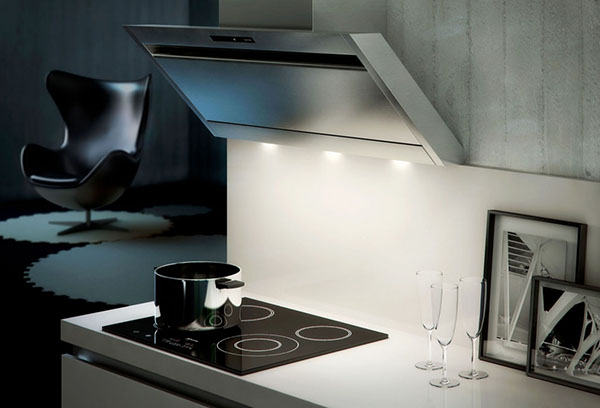How to choose a hood for the kitchen without an air duct? Filter Myths
In technical terms, recirculation or circulation hoods for the kitchen are not inherently because they do not remove polluted air, but clean it with the help of of filters and return back. From the point of view of specialists, this type of ventilation is considered the most inexpensive. For many kitchens, filter installations are the most acceptable option.
Hoods are of two main types. Evacuation (flow) carry out the withdrawal of polluted air outside the room through the ventilation shaft of the building. The recirculation system works according to the principle of a closed cycle, it is not necessary to bring the exhaust ducts to stationary ventilation. When using the recirculation mode, no serious work or rearrangement of furniture in the kitchen is required to install the hood. The polluted stream is pumped through filters that remove the smallest splashes of grease and unpleasant smell from it, the cleaned air mass is returned back to the room.
Flow system
Evacuation hoods () are more powerful, but they have many drawbacks:
- separate connection to the mine ventilation;
- mandatory installation of a check valve;
- need a constant flow of fresh air from the open window;
- separate costs for the installation of the duct in the case of a remote location of the standard entrance to the ventilation shaft;
- the installed system removes the heated air in the winter time, instead of the cold flow from the street, which negatively affects the heating, in the summer everything happens the opposite.
Therefore, hoods of this type are best used in specialized kitchens. cateringwhere they fully justify the connection costs. In apartments, especially small ones, it is more convenient and more rational to use recirculation systems.
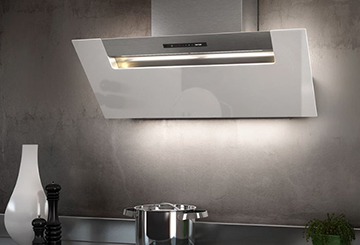
The principle of the recirculation hood
In high-rise buildings, there are often problems with the ventilation system: there is not enough traction or there is no ventilation at all due to clogged internal ducts. This is where an exhaust hood comes to the rescue, working without being connected to ventilation, or simply of the circulating type.
Fan rotates in a horizontal plane above the hob, pulling into the bell of the system streams of cooking polluted air. On the way, this stream encounters special filters that precipitate particles of fat on the mesh surface. Then there is a cleaning from smells, after that the air stream comes back to the room. After cooking, turn off the system and open the window to air to restore normal atmosphere.
Important! Humidity in the kitchen will not go anywhere without systematic ventilation, and the influx of fresh oxygen will only refresh the entire room.
In modern city apartments hermetic double-glazed windows are installed, which eliminate the noise from the street, but the flow of air into the room should be carried out constantly.

Work recirculation hood
Advantages and disadvantages of the design
When buying, choose popular models with standard sizes - it will be easier to find replaceable cassettes.
The downside is that such systems cannot be installed above gas cooking surface - they do not cope with the decomposition products of gas during combustion, while burning oxygen, recycling becomes ineffective and meaningless.
What filters apply
Ordinary mesh From the metal in the lower part of the housing, recirculation hoods are a necessary filtration minimum for any kitchen. They are designed to screen out small particles of fat from the air. Their action is quite simple: passing through a frequent metal mesh, polluted air flow leaves small particles of fat on their surface. The mesh pattern is more complicated and smaller, the greater the amount of fat left on it. After a certain time, the grid is removed and washed from the fatty deposit.
As a rule, the grids are made of stainless metal, in low-end models - high-strength aluminum.
Additional filters are used for cleaning odors:
- Disposable liners from paper, a synthetic winterizer or a flizelin. Replacement is made when the drawing on them becomes invisible.
- Acrylic, are found quite infrequently, but they are already reusable. When washing them, you must act very carefully, never squeeze, so as not to disturb the arrangement of the fibers.
- Coalfilters are more dense, therefore they retain the unpleasant odors of burnt oil. They are able to effectively clean the air. Cartridges with spent carbon filters are not reused, but replaced with new ones. The frequency of their replacement depends on the intensity of operation of household appliances.
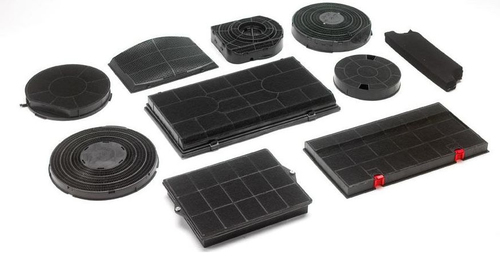
Carbon filters
Any manufacturer of exhaust, both recirculation and other samples, where there are filters, should indicate in the enclosed operating instructions the terms of their replacement. Some set the frequency of not more than 3 months, and others after prolonged use for six months.
The most advanced models of cassette filters are supplied indicatorsthat report marginal clogging. It is quite convenient - you will immediately find out the exact frequency of replacement. When selecting a cassette, pay attention to the absence of gaps; you simply cannot install oversized filters.
Filter Myths
Among users there are judgments about the benefits of various models of hoods. Basically, the debate is about the effectiveness of filters and the quality of removal of harmful impurities.
Low filtration efficiency
No exhaust system removes all odors from the kitchen area by 100%. The polluted air exhaust system is not suitable for all city apartments due to clogged ventilation ducts and shafts in apartment buildings. It is necessary to make separate conclusions from each apartment - you need a special permit. The main task of any hood is removal. combustion products, fat drops and soot, because their deposits on furniture and walls do not add surroundings to the interior of the room, and they are harmful to health. This problem is perfectly handled by the filters of the circulation system.
By the way, evacuation systems also have filters that protect the engine and air ducts, they also need to be periodically changed.
We conclude: regardless of the model of the hood, the complete removal of unpleasant odors is basically impossible. Both systems adequately cope with the task of removing soot and fat drops.

Recycling systems are more expensive
Now a little arithmetic: a kit for connecting a flow-through system to house ventilation will cost no less than 1 thousand rubles, if you need to hide air ducts, then add another 500 p to PVC pipes. Installation work plus permission - another 4 thousand rubles, a total of at least 1000 + 500 + 4000 = 5.5 thousand rubles. The cost of additional ventilation will not be considered.
Coal filters recirculation hoods cost at least 400 rubles, for a year you need no more than 2-4 cartridges. We get 800-1600 rubles. in year. As a result, we can use the recirculation system for at least 3.5 years, and a maximum of about 7 years, or spend it once on the evacuation type. In the calculations, we did not take into account that the filters are also in direct-flow systems, which also need to be changed.
Conclusion: the circulation hood is economically viable, the cost of replacing filters is evenly distributed over the years of operation.
Difficult to find filters
A fundamentally wrong statement: consumables, which include carbon filters, are made by other manufacturers, sometimes they even better qualitythan coming with a hood. Mark-up on the brand is not made, and to acquire the necessary filters is easy.
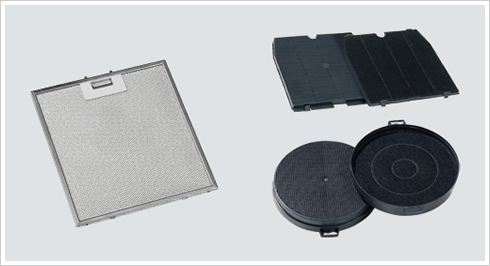
Filters degrade performance
Another misconception that was not supported by figures in any way - no one has ever carried out any research on this topic, much less any measurements or comparisons of characteristics. Modern carbon filters are very thin, they can not affect the power or.
The metal grids, which are present in all types of extracts and periodically washed, are clogged with fat.
Losses are present at montage direct-flow systems: one turn reduces efficiency by 10%, and without them there will be no hidden retraction - at least two bends will be necessary. We consider: it was 265 m 3 / h according to the instructions, they made a tap with two turns, minus 20% eventually got 265-53 = 212 cubic meters. m / h
Conclusion: do not believe the unverified information and false myths. Power and performance indicated with regard to installed filters.
Making the right choice
Autonomous type circulation hoods have different sets of functions that make them a little more expensive, but contribute to the convenience of working with them:
- touch screen panel for control;
- timer programmed for auto power on and off;
- automatic sensors that turn on the fan depending on the temperature or humidity of the air;
- separate control panel at a distance.
The main parameter when choosing a recirculation system is its dimensions.
Important to remember! Acquire only such a model that in its functional abilities and size is perfect for your cooking stove.
Must be several centimeters wider than your plate: only in this case the intake of polluted air will be maximum, accordingly, the efficiency of cleaning the air flow will be much higher.
Kitchen hood - a thing for the modern kitchen necessary. It hardly makes sense to put up with soot, foreign odors and fat settling on the walls, if there is an opportunity to solve all these problems. However, how to choose a hood, if you can not make a vent?
Types of hoods

The hood consists of an engine, a fan, and a system of filters that trap grease, soot, and odors. The fan is designed to create air draft. All the variety of hoods can be divided into two broad categories:
- exhaust;
- circulating.
Relevance
If the configuration of the room is such that the gas stove is far from the ventilation shaft, then the exhaust kitchen hoods become irrelevant. Pulling the pipeline and spoiling the appearance of the kitchen, few people want. Therefore, an exhaust hood without an air duct is actual, that is, circulating.
Similarly, such kitchen hoods are relevant for studio apartments, where the kitchen is not separated from the living area.
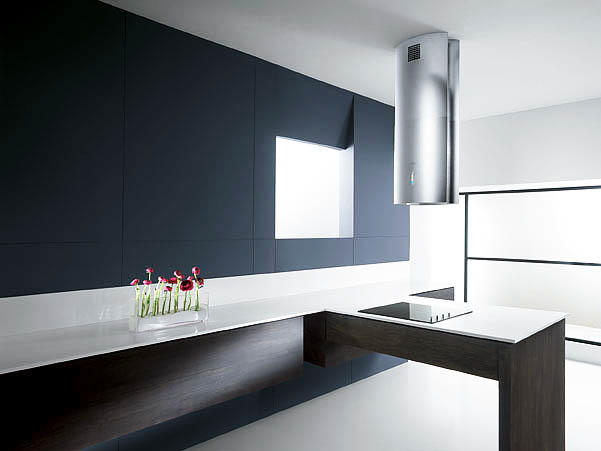

Exhaust models bring the polluted air through the pipeline to the ventilation shaft or to the street. Such a system requires an air duct, which is not always possible to organize.
Circulating cooker hoods do not have an air duct. They are equipped with filters that clean the intake air and return it to the kitchen.
The principle of operation of the hood without duct
In the circulation hood without an air duct, two types of filters are used:
- grease catchers:
- coal.
Coal is designed to clean the kitchen air from soot, dirt, odors, and grease traps - from fat. The principle of operation of the hood is based on the fact that in it the air is constantly circulating, cleaned and re-supplied to the kitchen.
Air ducts without air duct: advantages
This type of exhaust without an air duct has many advantages. The first and foremost is that you do not have to worry about the organization of the pipeline and methods of exhaust air. Such hoods can be used even in those rooms where, in principle, there is no ventilation duct.
Due to the fact that kitchen hoods without an air duct do not need access to the street, there is no need to constantly keep the vent open if air is organized through it. Accordingly, there is no heat loss and the room is kept warm. This is especially important in areas with a cold climate.
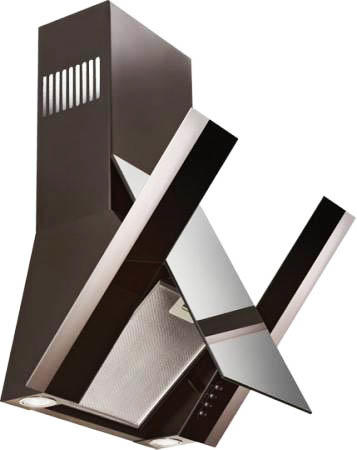

This hood is very easy to install. Even a person who does not have knowledge in the field of engineering communications can install it, because he will not have to think about the organization of the duct. To do this, just buy a hood, hang it over the stove and insert the plug into the outlet. There is no need to punch ventilation holes, pull pipes, change planning solutions.
Circulating hoods
Circulation hoods can be installed in old houses where ventilation ducts do not cope with their responsibilities. Similarly, it can be installed in the kitchen, where the work area is in the form of an island in the center of the room. It is enough just to hang the hood and not spoil the appearance of the room by air ducts running from the center of the room.
Circulation hoods without an air duct have a lot of advantages over exhaust systems, especially if in the latter air is taken out and air is taken in through ventilation shafts, and double-glazed windows are installed in the apartment. When the windows are closed, a low pressure zone is formed and air from the ventilation ducts of the entire riser and sanitary facilities is drawn into the apartment. In this case, it is difficult to talk about fresh air. The circulation system simply cleans the air and does not mix it with air from other rooms.
Important: If the house has a gas water heater, then the exhaust system would not be the best option, since it can break the draft in the ventilation shaft and the chimney and direct it to the other side.
In private homes, exhaust systems are justified and have advantages, since they can be perfectly integrated into the ventilation system. In homes with common air ducts, which are often clogged, kitchen hoods without an air duct are a great advantage.
Disadvantages of air vents without duct
In circulation kitchen hood efficiency is not as high as that of exhaust. As a rule, it copes with air purification at an average level - approximately 70% of the total amount of kitchen air is cleaned. This is due to the natural resistance of the filters to the flow of air due to physical laws. But for most standard kitchens this is more than enough.
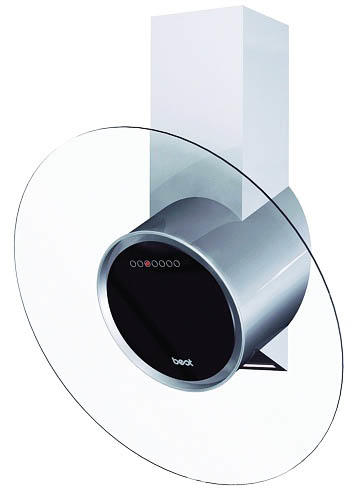
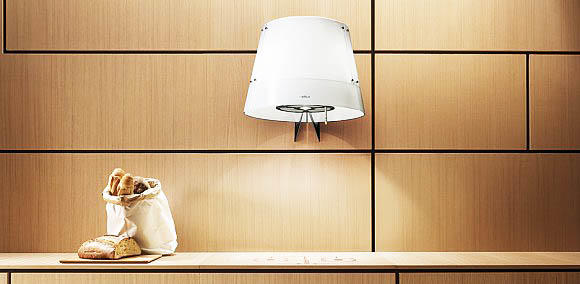
Maintenance of the circulation hood is more troublesome: once every 3 months there is a need to replace the carbon filters.
From the humidity in the kitchen the circulation hood without an air duct does not protect - it does not remove steam.
Another relative disadvantage - such kitchen hoods create more noise. However, with this drawback, many cope quite elegantly - kitchen hoods can be included during cooking. The rest of the time, the noise will not disturb anyone, as the hood will be turned off.
Types of hoods without duct
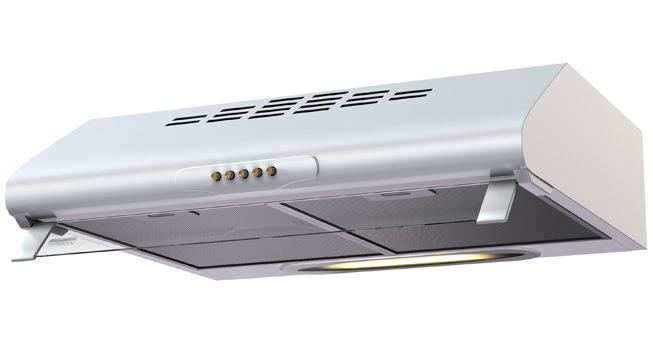
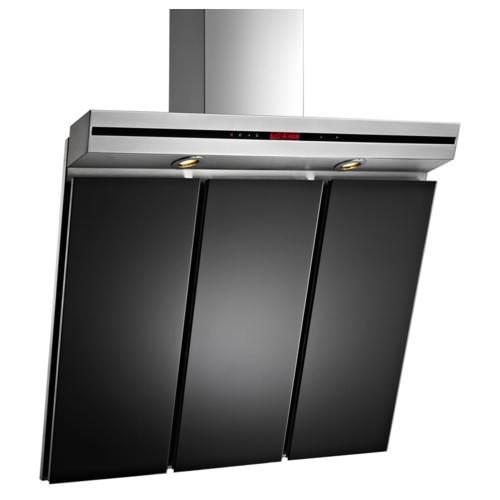
Modern models can be made of glass, metal and other materials. Chrome-plated hoods look very aesthetically pleasing.
The shape of the hood can be horizontal and vertical; mounted and recessed. Embedded are convenient because they allow you to hide them from the eyes and not spoil the look of the interior, especially when it comes to antique styling. From this point of view, a telescopic hood is very convenient, which can be put forward for the time of work and can be removed from the eyes again.
How to choose a hood without duct correctly
Pick up the kitchen hood can be yourself. There are several factors to consider when choosing:
- The width of the hood must match the width of the slab;
- When buying, you need to pay attention to power - it is important that the hood could make 6 air exchanges per hour. You can calculate the required power by yourself - for this, the kitchen volume is multiplied by 6-10.
Hoods without an air duct allow you to provide clean kitchen air with a minimum of effort. The main thing - to choose the right model that fits into the interior and satisfying in power.
Attention, only TODAY!
Hood in the modern house is a necessary element, since the level of comfort, if any, increases significantly. All such devices are divided into exhaust and circulation. Exhaust hoods with the discharge of polluted air outside the room are more efficient. But what if you can not arrange such a duct? In this case, exhaust hoods without ventilation are used, which allow air to pass through the filter system, returning it to the kitchen already cleaned.
Kitchen hoods are divided into two major categories:
1. With air exhaust (flow). In such devices, the fan draws air in, passes it through a grease catcher, and then sends polluted air into the duct. On the channel it is thrown out outside the room. If the ventilation duct is functioning properly, the air in the kitchen is constantly updated. Instead of the removed air, fresh air enters the kitchen. To ensure the quality work of the intake hood is desirable constant air inflow into the kitchen from the street.
2. Without air exhaust (recirculation). Such devices are not connected with air ducts. They work on the principle of air recycling. The engine uses a fan that drives air through two degrees of filtration. The first stage is a grease trap, which, in addition to fat, also retains particles of dust, soot, heavy types of fumes. Next is a carbon filter that cleans the passing air from odors and the smallest particles that have passed through the grease trap.
Circulating hood does not require air in the kitchen. For her work only need to connect to the mains.
There are also types of hoods for the kitchen without an air duct:
The shape of the case:
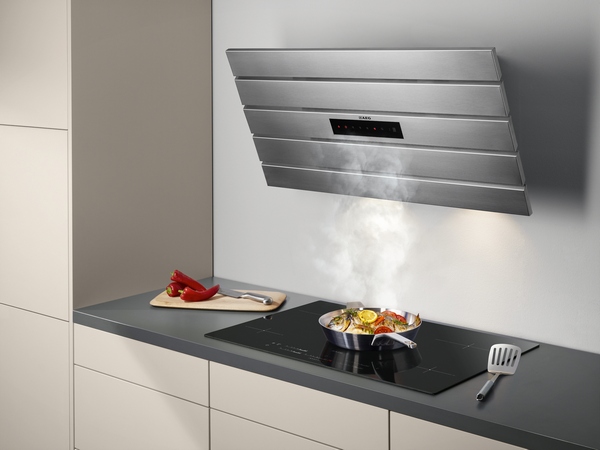
By design:

When does it make sense to install a recirculation hood?
There are many reasons why the installation of a flow exhaust device is not recommended:
- in the studio apartment. Additional air ducts that will be visible will not add aesthetics to such a stylish apartment;
- if the stove is located very far from the entrance to the ventilation;
- if initially the kitchen was designed without taking into account the exhaust hood;
- air ducts laid across the entire room can spoil the overall appearance of the kitchen;
- ventilation ducts are not functioning properly. The air in them does not go away, but returns back to the kitchen with all the existing smells;
- air drainage channels, as well as the hood itself do not fit into the interior of the kitchen.
Note also that the hoods for the kitchen without exhaust in the ventilation is much easier and faster to install.
Tip: If there is a gas column in the house, the circulation hood will be an ideal option, since the flow system can create backflow in the ventilation shaft.
Pros and cons of hoods without air
Before you choose a hood for the kitchen without an air duct, we recommend that you familiarize yourself with the positive aspects of these devices, as well as learn their negative aspects. With this knowledge, you can choose for your home such a device that would completely suit you.
Let's start with the positive qualities:
- an exhaust hood without a vent to the ventilation can be mounted not only in kitchens, but also in any premises, regardless of the presence of ventilation ducts in them;
- there is no need to ensure the flow of air into the room. This is especially important for kitchen rooms in which sealed double-glazed windows are installed, plus, cold air from the street in winter will significantly cool the room;
- circulation hood fits perfectly into the interior of any kitchen;
- it requires little space, does not clutter up even small kitchens with its presence;
- simple design that does not require to connect special knowledge. All installation work is easily performed independently;
- practically does not require maintenance;
- filter replacement is carried out in a short time on its own.
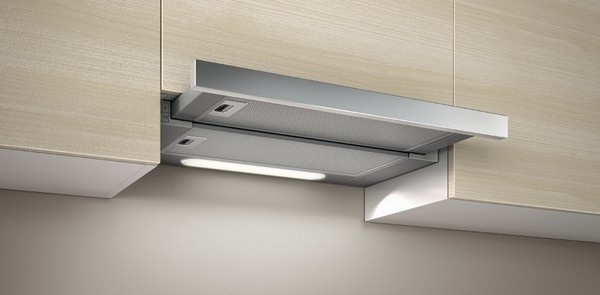
Hoods for the kitchen without an air duct are not without drawbacks:
- it is necessary to regularly change the active filter element, which leads to additional expenses. Usually the filter lasts for 3-6 months. After this period, the exhaust efficiency is reduced;
- such a device is less efficient than a flow hood;
- they are more noisy.
What to look for when choosing
To choose the right circulation hood, you need to spend some of your time to get acquainted with the main parameters of this technology:
Dimensions
The device should not be smaller than your plate. Let it be better that its dimensions slightly exceed the dimensions of the cooking surface.
Performance
The greater this figure, the greater the amount of air can clean the hood for 1 hour. It is considered normal if the air will be replaced 12 times in the kitchen. To determine the required performance of the hood you need to know the dimensions of the kitchen. The total area is multiplied by the height of the ceilings, and then multiplied by 12. For example, if the area of the room is 9 squares and the height of the kitchen is 3 m, then we get the required power: 9 x 3 x 12 = 324 cube / hour. This indicator is the minimum extraction power suitable for installation in a given room, which is recommended to be increased by 30 percent.
Note: If the kitchen is combined with some other room, then the total area of such a union is taken into account.
Speed adjustment
High-quality recirculation hood for the kitchen should have a minimum of 3 speeds to ensure ease of operation with different evaporation rates.
Backlight
This is a very convenient addition that allows you to light up the hob. As lighting elements LED lamps look more preferable.
Filters
The filtration system consists of an external filter (grease trap) and a carbon filter. Reusable metal nets or acrylic fiber inserts are used as grease traps. Disposable include sinteponovye, paper and non-woven filters. It is better to use reusable items because of their cost.
Additional functions
- the electronic display on the device panel will give all the necessary information about the performance of the hood without a pipe and its mode of operation;
- the filter status indicator will remind the owner of the hood about the need to replace or clean the filter element;
- auto-on and off sensors will allow you to fully automate the operation of the device;
- the periodic on mode will allow you to constantly maintain the freshness of the air in the kitchen;
- built-in timer allows you to customize the work of the hood on a schedule.
Popular manufacturers
Electric hoods for the kitchen without an air duct are produced by many manufacturers. Among them are the most famous, whose quality is the standard:
Bosch
Famous for its quality German company, which specializes in the production of household appliances for home and office.
Gorenje
Well-known Slovenian manufacturer, whose products are among the ten best European models of household appliances.
Electrolux
Products of this Swedish brand are known worldwide. The basis of production is the production of electrical equipment for the needs of the population.
Ariston
One of the European leaders in the production of household appliances. Company from Italy.
In addition to the listed companies, the products of such manufacturers as Kaiser, Hansa, ARDO, Samsung, Zanussi have excellent quality.
When choosing a hood, focus on the availability of the product at a price, as well as the functionality that it has.
Tweet
Plus
To make a hood in the kitchen is not a whim, but a necessity. After all, while the process of cooking is going on, a lot of “by-products” get into the air, which is unpleasant and unpleasant to breathe.
Fats, smells, moisture, soot, temperature changes - all this makes the kitchen microclimate extreme.
To catch the harmful particles, not to allow them to settle on the furniture, will help the kitchen hood without an air duct, or circulating. Why this one, how it differs from other options and how to choose it when buying - let's see.
At its core, the circulation hood is a local air purifier.
It sucks air over the stove, passes it through the filter system and returns it back to the room.
Since the suction rod is created by an engine with a fan, the cleaning rate depends on its power.
The design of modern units allows you to switch modes and use the same device as a ventilation and circulation method.
The internal device has a tap that connects to the ventilation duct (or does not connect - at the request of the owner), as well as openings for returning air back to the room.
Typically, different filters are used in the hoods. Some get rid of odors, others catch fumes, grease and other suspensions.
Pros and cons of the circulation hood
It is impossible to decide which exhaust system is better if you do not compare them with each other. As already mentioned, there are only two options:
- Without duct.
- With air duct.
What are their differences.
Effect of kitchen hoods on ventilation
 They are guided by the movement of air in the house, the laws of physics, and if we do a hood with an air duct, then only by all the rules, otherwise you can achieve the opposite result.
They are guided by the movement of air in the house, the laws of physics, and if we do a hood with an air duct, then only by all the rules, otherwise you can achieve the opposite result.
To carry out duct ventilation, you need to bring dirty air out, as well as a source of fresh and clean from the street.
Such a full-fledged system requires considerable financial investments. But is it possible to save on something, for example, to connect the exhaust air outlet to the general ventilation duct?
Some do that, but there are a few important points:
- In those moments when the hood is not included, the kitchen is devoid of any ventilation, because the hole in the shaft is blocked.
- If a fresh influx is not organized, the exhaust will begin to suck from the ventilation that dirty air that has gathered from all the apartments of the riser. It turns out that every time the process of cooking begins, you will have to open the windows.
- To make the mine work normally, it needs to be cleaned at least once a year. The services of ventilating brigades are not small, therefore, in apartment buildings, as a rule, no one does this, and the mines become so downtrodden that they do not cope with the work.
- If a gas boiler is used with gases in the same shaft, ventilation may cause backsplushing.
According to the safety rules, the output still needs to be done in a separate hole on the street.
Then maybe you can do without organizing the inlet? If the windows are old wooden frames, and the door pulls drafted, then you can. But if a good repair is made, there are plastic windows and a good door, then getting into the air in your home is very difficult. And if the inflow is not enough, then the outflow will not go!
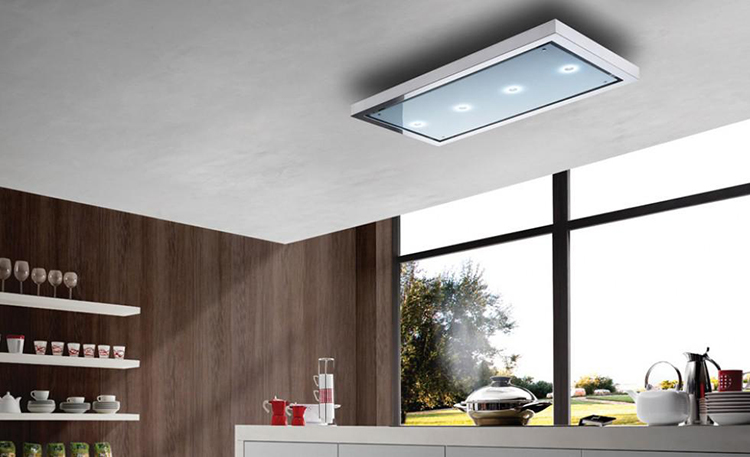
Kitchen hood in the interior
When it's warm outside, this problem is solved by simply opening the windows, but what to do in winter? After all, if even a little open the window, working hood, replace the warm air to the cold, in less than an hour!
It turns out that a kitchen hood without an air duct is the simplest, cheapest and most effective solution. At the same time, the ventilating common house shaft remains open and continues to perform its functions, and the air is additionally cleaned with filters.
Although here is not so rosy. Circulation hoods also have weaknesses.
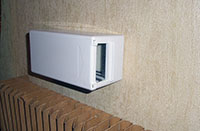 If you live in an area where the air is polluted and plan to install ventilation, then the best option would be a system with filters. : selection of equipment and calculation system.
If you live in an area where the air is polluted and plan to install ventilation, then the best option would be a system with filters. : selection of equipment and calculation system.
Algorithm for installation of exhaust ventilation, see.
The ventilation system is expensive, so many people think about whether you can do it yourself. Under this link you will find step-by-step instructions on the independent arrangement of the inlet ventilation system.
Advantages and disadvantages
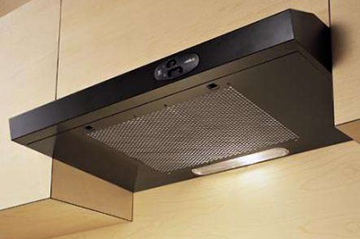
The advantages include:
- Easy installation.
- Cheapness (the unit itself is cheaper, saving on installation work).
- The fact that the hood does not close the exhaust ventilation.
- Ease of use (easy to change the filter, clean, no need to do ventilation, open windows, etc.).
- The ability to reuse the coarse filter.
- More freedom in where and how to arrange furniture in the kitchen. Indeed, in the case of a channel hood, the plate will have to be placed closer to the hole. A circulation hood will be located where the tenants want.
There are also disadvantages:
- The air cleaning efficiency is about half lower than that of the channel variant.
- The need to regularly change the carbon filter.
- It is difficult to determine when the filter needs to be replaced (if it is prepared more often, it clogs faster, but to say for sure that it is time to throw it away can only a special indicator, which is not in all devices).
- Circulating hood can not affect the humidity in the room. To get rid of excess moisture, you can additionally purchase a dehumidifier.
- This hood is more noisy when working.
As you can see, the circulation hood is also not an ideal solution, so if the funds allow, it is best to do a full supply and exhaust duct ventilation!
How to choose a hood for the kitchen without an air duct
Consider the features and parameters that need to be considered.
Power
The performance (or power) will determine how easily and quickly the device will cope with air cleaning. In order for the system to be truly effective, it must drive the entire volume of the room through 6 to 12 times per hour.
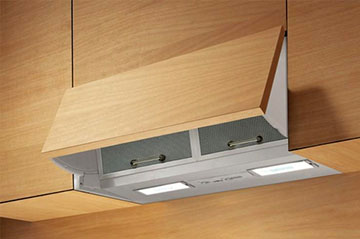 Based on this, the power is calculated:
Based on this, the power is calculated:
- The kitchen area is located (the length is multiplied by the width).
- The volume is calculated (the area is multiplied by the height).
- The resulting value is multiplied by 6, 7, 8 ... or 12.
For example, if area = 9 m 2 and ceilings 2.8 m.
The volume of the room will be 9 x 2.8 = 25.2 m 3.
The weakest extract that can be purchased: 25.2 x 6 = 151.2 m 3 / h
The best option: 25.2 x 12 = 302.4 m 3 / h.
Filter
In the hood is installed two types of filters:
- Carbonic.
- Fat-absorbing.
Coal - a very effective adsorbent for odors based on activated carbon. Requires replacement as pollution (on average after 2-6 months).
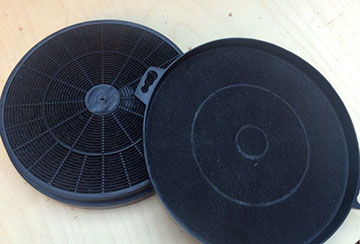 Fat-absorbing agent picks up dirt from the air.
Fat-absorbing agent picks up dirt from the air.
Including protects them from the internal parts of the hood.
There are three types:
- Metallic.
- Acrylic.
- Non-woven or paper.
Metallic made up of layers of aluminum. It is worth buying filters in which there are 5 or more layers, otherwise they are simply not effective. This aluminum mesh can be washed in a dishwasher (separate from the dishes) and re-used.
Acrylicfilters can also be washed in warm soapy water.
Paper - This is a one-off filter option. There is text on its surface. As soon as it cannot be distinguished - the element is thrown out.
It is important to change the filtering devices in time, not only because the exhaust efficiency decreases, but also because the oil and fat accumulated on the grill can ignite during cooking.
Noise level
Circulating hoods in the kitchen without an air duct create a sound that can be annoying. It is necessary to take into account that the larger the unit in size, the greater the noise from it. You can purposefully look for models of small sizes.
In the data sheet should indicate the sound level. There are models with a lower figure. A level up to 40 - 42 dB is considered acceptable.
Design
Consider the types of hoods for the kitchen without an air duct. Hoods are available in five variations in the form:
- Dome (classic bulky view).
- Inclined (outwardly similar to the LCD TV, take up little space).
- Island (do not have a back wall, mounted, may be round).
- T-shaped (another type of mounted devices, but with a flat bottom surface on which the control panel can be placed).
- Built in (after installation in kitchen furniture, only the bottom plane of the appliance is visible).

Dome hood in the interior of the kitchen
Other options
Also need to consider:
- Unit size (measured by the width of the embedding, if the device will be placed between the cabinets).
- What kind of control - mechanical or electronic.
- The presence of the backlight.
- Conveniently, if there is a built-in timer, clock.
- Is there a filter change indicator?
- Is there a remote control.
Cost of
Prices for the simplest exhaust devices can start from 3.5 thousand rubles. But on average, a unit of good quality will need to pay 10-25 thousand rubles.The cheapest are recessed hoods without an air duct - approx. 3.5 - 10 thousand rubles.
Example: Ukinox Compact 600.300.420 WH (Russian) mechanical control, 60 cm in width, 51 dB of noise, power 420 m 3 / h., 2 speeds - 3600 rubles.
Also reasonable prices for inclined models that look very modern. Example: Akpo WK-4 Nero eco 50 BK (Polish) mechanic, 50 cm wide, 52 dB noise, 420 m 3 / h, 3 speeds - 8000 rub.
Island models will be the most expensive because they have a unique designer look. Prices start at 30 thousand rubles. and may exceed 100 - 120 thousand rubles. Example: Maunfeld Berta with transparent glass (English) - electronic control, 90 cm in width (glass diameter), 46 dB of noise, power 1050 m 3 / h, 3 speeds - 44 thousand rubles.
Carbon filters are produced in different shapes and sizes (selected by brand). The cost of the elements - 750 - 1000 rubles. If there is a higher price, you need to see how many pieces are included in the kit - perhaps this is the wholesale price of several copies.
Conclusion
Channelless hoods for the kitchen are worthy of attention - they are economical, simple and reliable. If you still doubt the effectiveness of the device, you can install it as a "trial" option. Since modern devices in the overwhelming majority can operate in two modes, it will never be too late to cut a hole into the street and connect an exhaust hood to it.
Video on the topic
So that the kitchen does not accumulate unpleasant odors, it is necessary to put a hood on it. But there may be limitations imposed by the design features of the room. In particular, it is not always possible to place a classic hood, because it is not everywhere that there is a duct or it can be easily equipped. But this is not a problem - the solution will be a kitchen hood without an air duct. Let us see what it is, how to choose it correctly and what devices of this type are.
Principle of operation
Hoods that use duct in their work are flow-through. Their essence lies in the fact that they tighten the air from the room - and throw it into the common ventilation channel. Air renewal takes place through loosely closed windows facing the street. This is a fairly effective option for cleaning the room, since the polluted air is completely removed from the room, being replaced by a new one. But the limitation is the presence of an air duct - the ventilation system of the house as a whole or a separate outlet to the outside.
How does the hood without duct work? Such electrical equipment is usually built on the principle of recycling systems. In other words, the devices draw polluted air into a special tank. There it is thoroughly cleaned, passes through special filters, after which, in its pure form, it re-enters the room.
Circulating hoods for the kitchen without an air duct filter the air in two stages. On the first, rather large particles of soot and soot are sifted out. At the second stage, more serious purification is carried out, in which smaller particles are removed, which are responsible for the appearance of unpleasant odors in the room. There are also combined models that can work in both modes.

More about filters
In total, up to 4 filter elements are usually found in the hood. The filter of the first level is fat-absorbing. It can be made of metal (usually aluminum, due to its lightness and low cost), acrylic canvas or paper (more rarely, non-woven fabric and synthetic padding). The first two options are designed for reusable use, the last - disposable, they should be changed when they completely cease to be visible due to accumulated pollution a special indicator.
Replace or flush the filter should be not only for reasons of air cleanliness, but also by the rules of fire safety. Abundant accumulation of grease and soot on its surface can be ignited if accidentally hit by a spark or intense heat.
The filters of the second level, purifying the air from unpleasant odors, contain activated carbon with various additives. Their lifespan depends on the model, intensity of use and other factors, but on average they are not changed more often 3-4 times a year (slightly less often than water filters).
Benefits
Hood for kitchen without duct has the following advantages:
- does not interfere with natural air exchange of the room;
- easy installation - there is no need to connect to the duct, enough to connect to the mains and fixing in furniture or on the wall;
- ease of construction;
- compactness, which is especially valuable in conditions, as a rule, of small kitchens in Russian homes;
- easy care;
- suitable for kitchens of any size and configuration;
- independent work (there will not be, for example, problems with a clogged ventilation channel);
- low price of both the device itself and its installation.
But not without flaws:
- frequent replacement of filters is required (and costs for them, respectively);
- less choice of models (refers not so much to the technical diversity of devices, as to the variants of their design design);
- somewhat worse degree of air purification;
- no effect on indoor humidity.
Execution options
The most common types of hoods for the kitchen without an air duct are as follows.
- Flat hood. It is based on a body panel, filters and a fan that draws air. It is possible to distinguish both vertical and horizontal hoods of the flat type.
- Built-in hood. Its design is similar, but it is closed by a hanging closet or panel, so as not to attract attention.
- Telescopic hood. A variety of embedded, the difference lies in the fact that if a need arises in it, you do not need to open the panel, but put forward the hood itself.
Also, circulation hoods for a kitchen without an air duct may differ in the material from which their body is made. Usually glass or chrome-plated aluminum is used.
As for the functional, simple models are equipped with mechanical control and a minimum of possible settings. More expensive are equipped with convenient touch screens and remote controls, and the possibilities of technology are much wider: clocks, timers, temperature and humidity sensors, setting up periodic automatic on and off, indicators of filter contamination, different intensity of air purification, etc.
Principles of selection
To choose the right hood for the kitchen, you need to pay attention to a number of factors:
- Design. It is important because the hood must be combined with the interior. The choice of models without an air duct is small, so there are not so many design solutions on the market. In a pinch, you can always give preference to a minimalist, uncluttered design that is neutral enough to be combined with any interior.
- The size. First, the model of the hood should be placed in the kitchen and not interfere with other pieces of furniture. Secondly, it should be understood that the larger the working surface of the machinery, the more effective the cleaning will be. The length and width of this surface are determined by the size of the stove and the dimensions of the kitchen, but the height relative to the stove must be at least 65 cm for electric and 75 for gas.
- The noise level (this figure is directly dependent on the power and dimensions of the device, so you should not get too productive and a huge unit in a small kitchenette). It is considered normal if the hood is not noisier than 40-45 dB.
- Performance. For an optimal cleaning level, the entire volume of kitchen air should pass through the hood 6-12 times per hour. It is easy to calculate the minimum power required - the volume of the room (the product of height, width and length) is multiplied by 6. For example, for a room of 25 cubic meters, an extract of at least 150 m 3/60 minutes is required.
- The range of settings on which the simplicity and ease of use of the device directly depends.
- Availability and price of consumables (once having saved money on technology, you can then repeatedly overpay for expensive or rarely available commercial filters).
- Cost (for the simplest devices, it starts from 3-4 thousand rubles; for a fairly powerful, productive, and flexibly adjustable extractor for a kitchen without an air duct, the price is already in the range of 10-20 thousand rubles).
Hood care
The most important component of the maintenance of exhaust equipment - timely replacement of the filter. A number of models are equipped with indicators indicating the need to change the filter elements. If they are not there, the fact that it is time to change the filters will remind the deteriorated quality of air purification in the room.
If the hood to the kitchen without an air duct is equipped with a paper or non-woven pre-filter, it is simply changed to a new one, since it is intended for one-time use. Acrylic or metal filters can be cleaned of contamination by washing in a dishwasher or manually in soapy water, dried and reused. Coal odor absorbers also need to be replaced; in the second round they cannot be used.
You should not wash the filter in the dishwasher along with dirty dishes - particles of dirt and grease from it can clog the filter holes, thereby spoiling it.
The body of the device itself should be regularly cleaned of accumulated dirt, using detergents suitable for the surface material. On this, in fact, all - with the observance of these simple rules extract will serve in the kitchen for many years.
Summing up
Hoses without an air duct, working according to the recirculation principle, are a convenient and practical solution for almost any kitchen, be it huge and luxuriously decorated, or very tiny and having a minimalistic and extremely practical design. With timely replacement of filtering elements and proper selection of performance, such a technique fully ensures the purification of air in the room, is simple both in installation and in subsequent maintenance. If there are still some doubts, you should pay attention to the universal combined devices that can operate in the mode of recirculation or exhaust air into the ventilation system.

